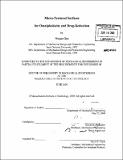| dc.contributor.advisor | Gareth H. McKinley. | en_US |
| dc.contributor.author | Choi, Wonjae | en_US |
| dc.contributor.other | Massachusetts Institute of Technology. Dept. of Mechanical Engineering. | en_US |
| dc.date.accessioned | 2009-11-06T16:30:27Z | |
| dc.date.available | 2009-11-06T16:30:27Z | |
| dc.date.copyright | 2009 | en_US |
| dc.date.issued | 2009 | en_US |
| dc.identifier.uri | http://hdl.handle.net/1721.1/49756 | |
| dc.description | Thesis (Ph. D.)--Massachusetts Institute of Technology, Dept. of Mechanical Engineering, 2009. | en_US |
| dc.description | Includes bibliographical references. | en_US |
| dc.description.abstract | When a liquid droplet contacts a surface possessing the appropriate combination of surface texture and solid surface energy, the liquid may not penetrate into the surface texture. Instead, the droplet sits partially on air, forming a solid-liquid-air composite interface. Entrapped air pockets of the composite interface are known to cause various interesting phenomena such as super-repellency, low hysteresis, and liquid slip. The current thesis research aims to extend the understandings about the role of surface texture on the static and dynamic behavior of the liquids forming composite interfaces on these textured surfaces. The first part of this thesis investigates the ability of surfaces with re-entrant texture, i.e., topography which bends back on itself, to promote the formation of composite interfaces against low surface tension liquids and display omniphobicity, i.e., repellency against a wide range of liquids regardless of their surface tension values. Surfaces that display contact angles of 0* > 1500 with liquids having appreciably lower surface tensions are attained by the incorporation of re-entrant surface curvature. The second part is an expansion of the classic Cassie-Baxter model that is widely used to predict the apparent contact angles on composite interfaces. A liquid droplet sitting on composite interfaces shows a range of apparent contact angles and corresponding contact angle hysteresis when the drop advances or recedes. The Cassie-Baxter model only predicts a single value of the apparent contact angle, and consequently, the model is inherently unable to provide an explanation for the hysteretic behavior of the liquid droplet. | en_US |
| dc.description.abstract | (cont.) In this thesis, the classic Cassie-Baxter relation is extended to predict the contact angle hysteresis observed on textured surfaces as well. In the final part of this thesis, the drag-reducing ability of composite interfaces will be investigated. It will be shown that the robustness, i.e., the resistance against a pressure perturbation, of composite interfaces and the amount of drag-reduction on these interfaces are negatively coupled. An approach to decouple these two important characteristics will be proposed based on the concept of dual-scale textures. | en_US |
| dc.description.statementofresponsibility | by Wonjae Choi. | en_US |
| dc.format.extent | 167 p. | en_US |
| dc.language.iso | eng | en_US |
| dc.publisher | Massachusetts Institute of Technology | en_US |
| dc.rights | M.I.T. theses are protected by
copyright. They may be viewed from this source for any purpose, but
reproduction or distribution in any format is prohibited without written
permission. See provided URL for inquiries about permission. | en_US |
| dc.rights.uri | http://dspace.mit.edu/handle/1721.1/7582 | en_US |
| dc.subject | Mechanical Engineering. | en_US |
| dc.title | Micro-textured surfaces for omniphobicity and drag-reduction | en_US |
| dc.type | Thesis | en_US |
| dc.description.degree | Ph.D. | en_US |
| dc.contributor.department | Massachusetts Institute of Technology. Department of Mechanical Engineering | |
| dc.identifier.oclc | 456717429 | en_US |
